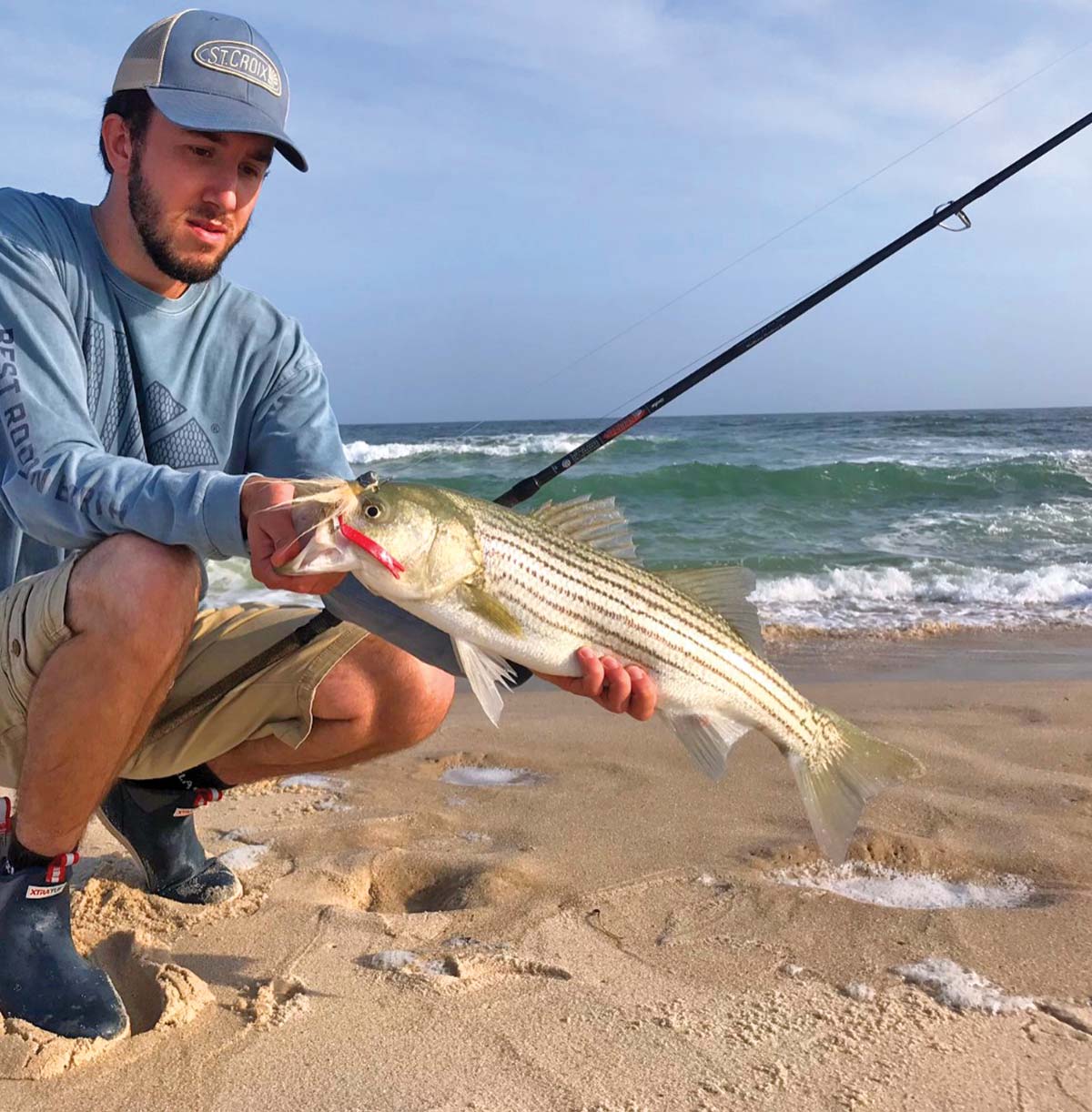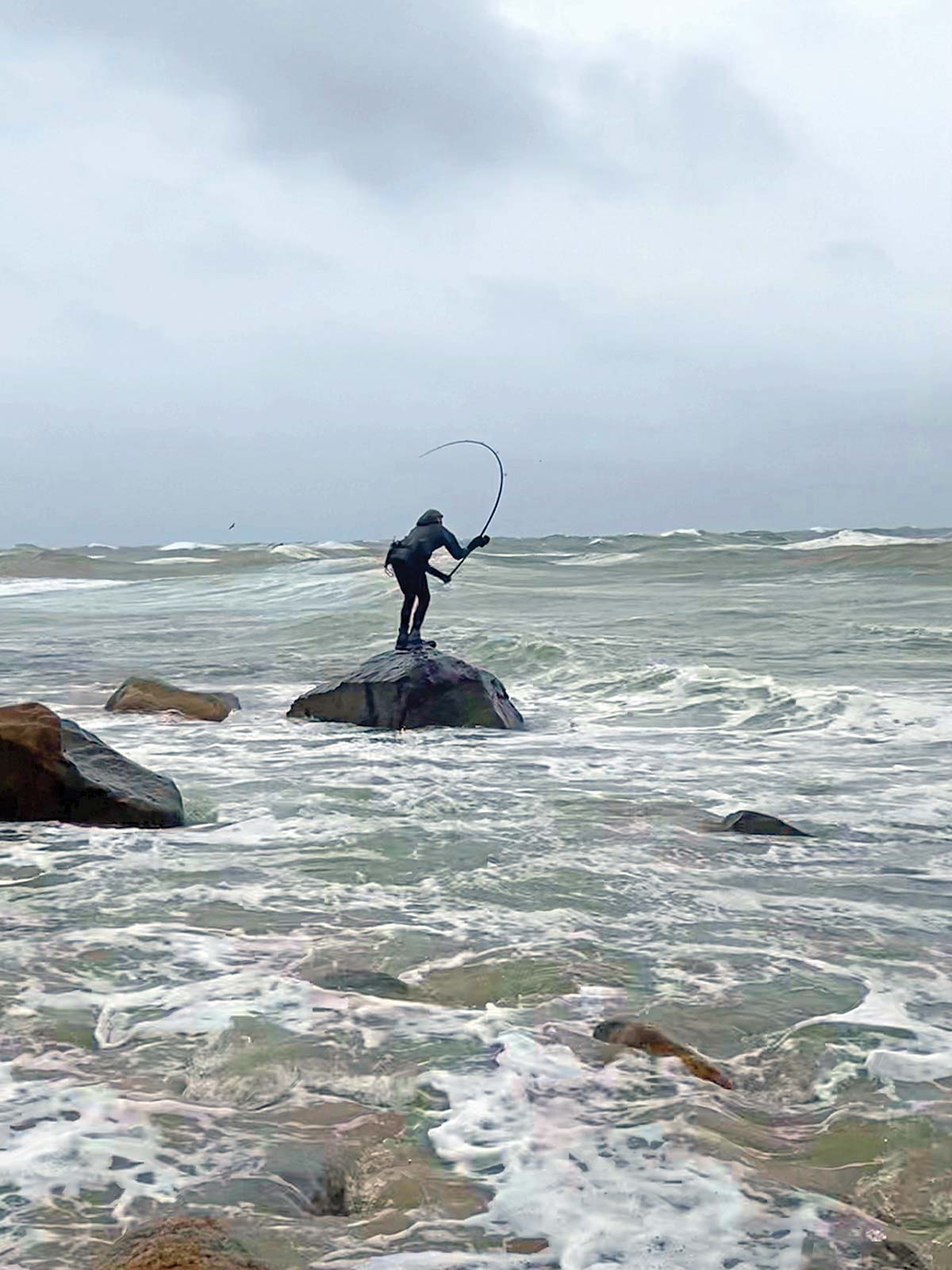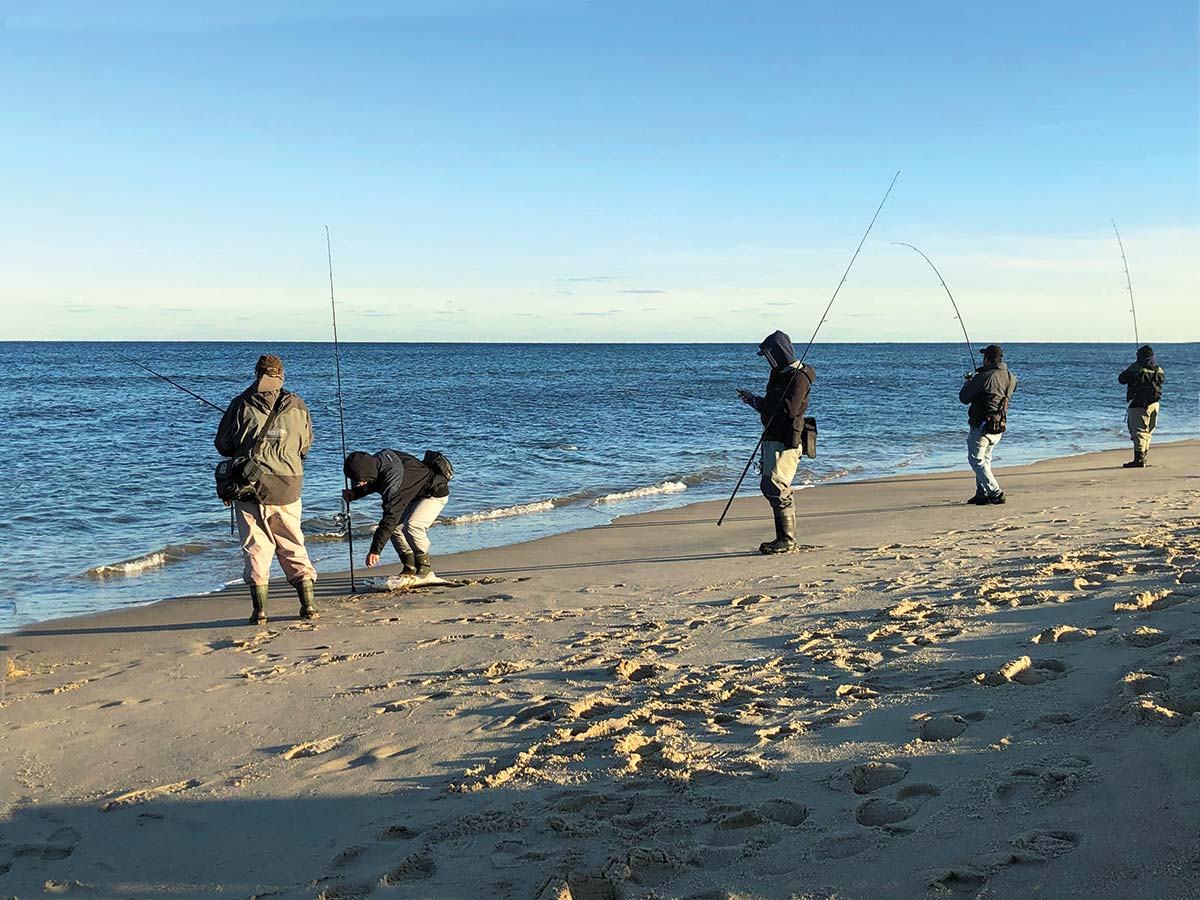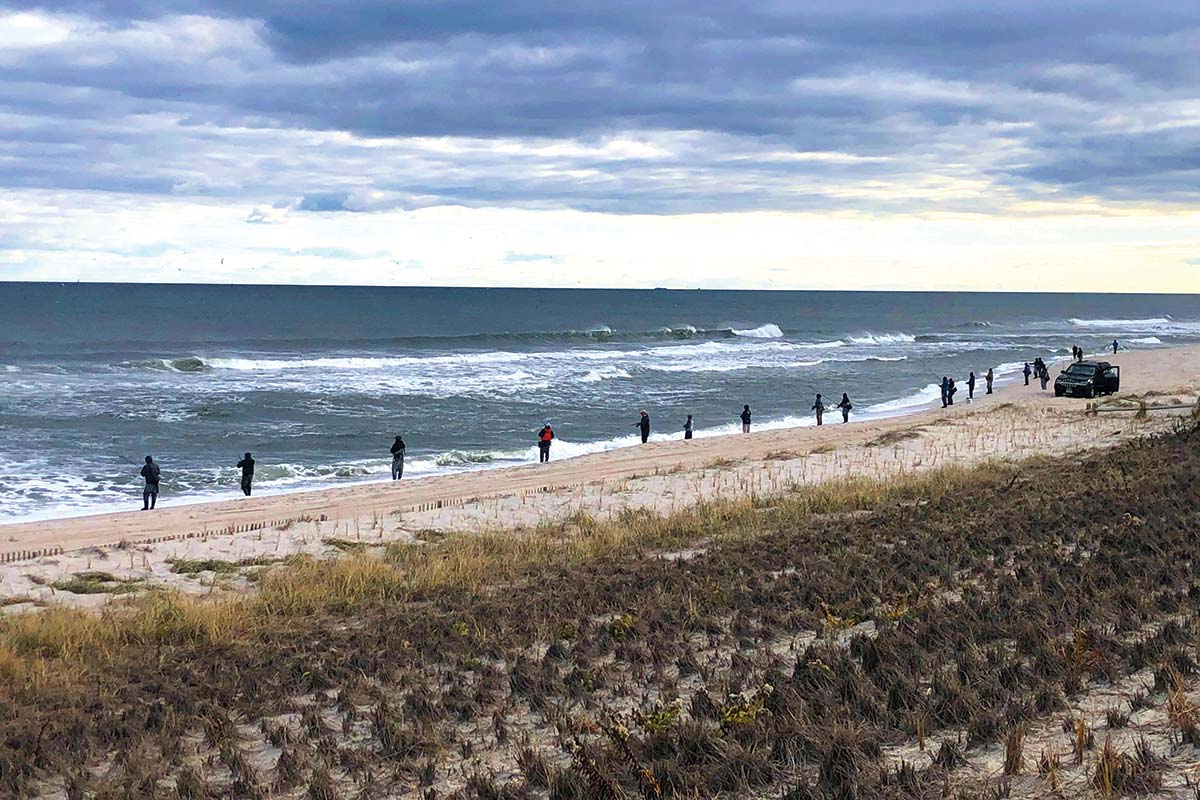
And so it begins…
Join our editorial staff from the New England, Long Island and Metro New York, and New Jersey, Delaware Bay editions of The Fisherman Magazine as we follow the fall run of striped bass essentially from north to south, from September through November, with your best opportunities to score along the shore.
A Classic New England Run?
I don’t think anyone would refute the claim that the temperatures have been well above normal starting January 1 of this year. In the process of collecting reports for our New England edition, the evidence is staggering; more and bigger striped bass (and bluefish) traveled further north than we typically see and I believe the mild winter and hot summer played a big part in that. The good news is that I also believe this could be setting the stage for an old school fall run, with several waves of fish passing along our coast, keeping the fall run hysteria alive all month long and well into October.
We can use recent history to pinpoint some places to watch closely as the run picks up in intensity. One area that has seen some crazy fall blitzes over the past couple years is the Scituate, Massachusetts shoreline from First Cliff down to Third Cliff there has been some amazing action here and – in some instances – it has lasted for more than a week at a time! When the action dries up here, keep an eye on Plymouth’s White Horse Beach, especially the rocky portion at its north end.

The Canal will undoubtedly produce some of the best action seen by land-based fishermen this fall. While the west end has gotten all the press this season, my advice is to shift your focus to the east end starting in September and – when the wind blows hard from the northeast – call in sick! We’ll still have young-of-the-year herring leaving the run for at least the first half of the month which will keep the mackerel coming in to dine, September usually sees some good runs of squid, which will only intensify the striper blitzes when they enter the canal to find a two-course tasting menu. The ninth month can also usher in some oddball baits like butterfish, halfbeaks and chub mackerel, so make sure you’re well-equipped to cover a wide range of sizes and silhouettes.
What could be more ‘classic’ than fishing Point Judith or the South County beaches during the fall run? While Rhody has lots of fishy water that will see some intense action this fall, the 20 mile stretch from Point Jude to Watch Hill will play host to a lot of it. Point Judith is a great spot to fish in snotty weather, especially at the start of a northeast blow—day or night, this famous spot puts out some serious fish. Night casters will do well with needles, darters and soft plastics threaded onto leadheads. Daytime casters will score best with pencils, bucktails or conventional poppers.

Heading west, the West Wall is known for its albie access, but it puts out some solid stripers on stormy days or in the deep of night. One last spot that produces some tanks in the fall is Deep Hole, at the east end of Misquamicut State Beach; metal lips, pencil poppers, plastic swimmers and large needlefish all fish well in and around Deep Hole. From here we enter run-and-gun territory. Anglers can make strategic moves from Matunuck State Beach to Charlestown Breachway to Quonny Breachway to Fire District Beach to Weekapaug Breachway to Misquamicut State Beach scan the water with binoculars to find blitzes of bass, blues and sometimes albies. After dark, hit the rocky points or the breachways with darters, bottle plugs and the Sebile Stick Shadd for a chance at connecting with a true Rhode Island cow. And don’t leave Watch Hill or Nappatree Point untouched either, these spots produce some giants, especially in ugly weather.
Connecticut is a tougher nut to crack with access being a problem in so many areas. Those with a fishing bike will open up many more options. The mouth of all three major rivers (Thames, Connecticut and Housatonic) hold tons of promise and have a long history of producing big fish in the fall. Live eels and fresh bunker chunks hook a lot of big fish along these shores. Pluggers will want to pack a diverse bag, with surface and deep metal lips, heavy and surface needles and a selection of darters to cover the diverse terrain and currents of Long Island Sound.
We’ll have the vast schools of peanut bunker leaving the estuaries to thank for a lot of the blitzes we see this fall, but there will be other players in this game. Atlantic mackerel, for example, have been making a steady comeback along the shores of Massachusetts and Rhode Island and they can really fire things up. Chub mackerel too, draw attention from stripers, but if you see bass on the chubs, they’re going to be large! Mullet are a big player in South County, pouring out of the breachways and Narragansett Bay, when the mullet run gets hot the fishing can be downright insane!
September in New England offers the best fishing over the widest possible area, but it moves fast, so don’t let it get away from you!
– D. Anderson
A New York State Of Mind
While the mullet run surrounding the Long Island and Metro area isn’t what it used to be, probably due to changing patterns and warmer weather pushing further into September, I can assure you that the first signs of the fall run will start to appear during the beginning of this month. Despite the hot days, the nights seem to change and the air gets this ‘crisp’ feeling to it. This nighttime chill stirs the bait staging within the bays around the region, triggering the first bites of the “run.”
Thinking back upon last year, these initial signs started somewhere in the beginning of September based off The Fisherman surf column reports that I conduct weekly in our Long Island, Metro New York edition. The hordes of peanut bunker reaching just the right snack size for stripers are gathering near all the major South Shore inlets and the resident fish in the bays are feasting on them. This is mainly a dawn/dusk bite with some decent action taking place after dark also. My selection for this type of fishing includes smaller poppers like Tactical Angler Crossover poppers, and Yo-Zuri Hydro Pencils, Poppers and Twitchbaits.

I’ve also found good success with Rebel Jumping Minnows and the smallest Super Strike Little Neck Poppers. The 4-1/8 and 5-inch Mag Darter also represent these peanut bunker well and finds a place in my surf bag during this time of the year. On the plastic side I’m looking for something with a bit of a wider profile to match those peanuts. Tsunami Shads in 4 and 5-inch, in pearl and bunker patterns are another staple while No Live Bait Needed (NLBN) 5-inch Paddletails rightfully earn themselves a place in my plastics pouch as well.
As the month progresses towards its end, the first signs of migratory fish start to make themselves known. I can almost always bet that by the end of September and within the first few days of October a nor’easter will hit the area, dropping the barometric pressure, moving bait close to shore, hence creating and excellent surf fishing situation. It’s well known that Montauk gets hot under these conditions along the north side of the point but I’ve come to learn that it’s not just Montauk that will produce during a nor’easter. Most places that are fishable with clean water during the storm will offer opportunity for some epic fishing. Some of the spots where I’ve seen epic fishing during this type of storm are all of the South Shore inlets, and the entire North Shore. The east sides of the points and coves on the North Shore especially since that will be right in the face of the wind direction and the bait will get blown right into those areas.
Fishing these conditions is also a battle in itself. Don’t think you will go out and fish a hard northeast blow like a walk in the park. Every cast requires some sort of extra effort. We like to refer to this as “punching through the wind.” On top of the extra effort requires some heavier tackle to launch heavier payloads a sufficient distance to reach fish. This isn’t always true as a northeast wind could put fish literally at your feet but at the same time if the fish are 30 of 40 yards or so out, you will need the heavy stuff to reach them in those 25- to 40-mile per hour winds. Ten to 11-footers are the right choice for delivering lures where they have to be. Speaking of lures, a lot of them become tough to use under these conditions. I usually opt out for a simple bucktail, heavy rubber shad or tin when this situation arises. You’re going to need something heavy enough to cut through the wind but light enough so it doesn’t sink to the bottom like a rock. Carrying lures in the 1 to 3-ounce range usually will do the trick.

With the amount of miscellaneous bait inside the bays right now around the island, September should be a solid month for surfcasting. The stage is being set and all the characters just need to come out to play their role. The only thing I could add is that with the warmer temperatures so far this season, things could be pushed back a week or so. September could be good but be ready for the end of the month and the beginning of October when things could really kick into gear in the Long Island/Metro area.
– M. Broderick
Greetings From The Jersey Shore
It will be 41 years this September 21 since the late Al McReynolds made long-standing history by plugging up a 78-1/2-pound striped bass from the Atlantic City surf. As the story goes, that night found McReynolds staring into the teeth of a nor’easter at the height of the mullet run, with a Rebel windcheater finding its mark on a striper that stands today as the largest ever caught (read: registered) in the modern era of surfcasting.
Mullet runs at the Jersey Shore ain’t what they used to be; sure, we’ll see a drizzle of these finger-sized morsels along the front beaches from mid-September to mid-October, but without a healthy dose of onshore wind from the east it’s rare to find many good bass in the mix. But if 2022 stands as a guide to Jersey Shore surfcasting in 2023, the first good shot at big fish could very well come this month around the time of the full moon on September 29.

Late September saw a steady string of northeasterly wind and swells; in fact it was the remnants of the tragic Hurricane Ian that ultimately developed into a regional nor’easter in early October of ’22. Looking back at my records, after this particular dose of onshore nastiness the winds turned out of the W/NW on Friday, October 7, and the very next day the fall bedlam began with giant stripers piling on adult menhaden.
Livelining in the surf, large white swim shads, pencils and metal-lips all took their fair share of big stripers for those first few days of the month, but things settled down quickly after the full moon on October 9. Night shifters tossing blurple Bombers, Mag Darters and SP Minnows will typically keep their successes (and failures) a secret through the month of October, but the best bet for a good fish is certainly during nonhuman hours.
Unlike South Jersey surfcasting during the McReynolds era, the epic-ness of the Garden State striper run truly arrives in November with the northern stretch of beaches from the top of Ocean County at Point Pleasant to the tip of Sandy Hook in Monmouth County getting the “hotspot” nod. Again it’s all about those bunker – pogies if you will – as adult menhaden move down just off the beach while young-of-the-year peanuts in particular come flowing out of Raritan Bay with each changing tide. That to me is what led to a sustained surf bite in North Jersey last season, especially with the prevalence of W/NW winds helping pushing baits out of the big bay last fall.

If you’re looking to fish blitz conditions, November is the month to remember at the Jersey Shore; a few good storms in September and October should provide the early impetus, and I still believe that “west is the best” when it comes to wind conditions, as bait noses up into the wind drawing predators nearer shore for the ambush. This season should see the Sandy Hook to Asbury Park stretch seeing solid action through much of that month, though look to Manasquan around Thanksgiving, and then prepare to run south to Island Beach or down the Parkway towards LBI as the run progresses.
Most of the action is sandy beach, so waders should suffice (keep the jetty walkers handy though should you find yourself hoping to stalk the inlet rocks from Shark River all the way to Cape May). Pack the pencils and Polaris style poppers for sure, also the peanut-size metal-lip swimmers or gliders when fish are in tight. Often times it’s a white bucktail with Otter Tail dressing that gets the nod, but when these bass are corralling bunker in along the beach a pocketful of white Tsunami swim shads or NLBN baits could probably get you through an entire session.

I don’t know what it is about Atlantic and Cape May counties where surfcasters staying home have been mostly picking at fish. Perhaps it’s the heavy flush of cooler water coming out of Barnegat Inlet on each outgoing tide, or maybe the fact that stripers – like we as anglers – don’t need to leave fish to find fish, as there’s just so much available food in the north that these stripers just stay until it’s time to go.
The fact of the matter is this – the Jersey Shore striped bass run was one for the ages in 2022, and if this October into November is even half as good as it was last year, it’s well worth the trip!
– J. Hutchinson




